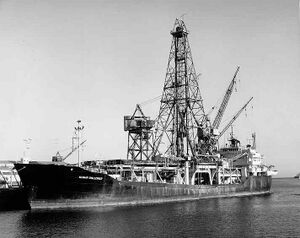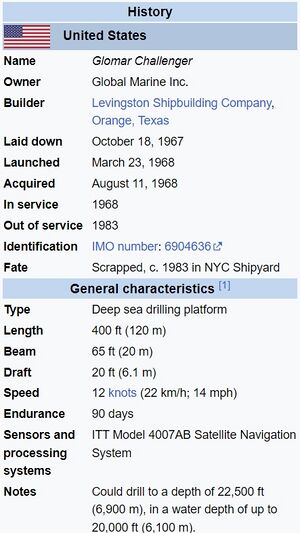Glomar Challenger
- This article is about the oceanographic research and deep-sea drilling vessel
For the CIA ship used to recover a sunken Soviet submarine during the Cold War, see Glomar Explorer
For the CIA ship used to recover a sunken Soviet submarine during the Cold War, see Glomar Explorer
The Glomar Challenger was a deep sea research and scientific drilling vessel for oceanography and marine geology studies. The drillship was designed by Global Marine Inc. (now Transocean Inc.) specifically for a long-term contract with the American National Science Foundation and the University of California Scripps Institution of Oceanography and built by Levingston Shipbuilding Company in Orange, Texas. Launched on March 23, 1968, the vessel was owned and operated by the Global Marine Inc. corporation. Glomar Challenger was given its name as a tribute to the accomplishments of the oceanographic survey vessel HMS Challenger. Glomar is a truncation of Global Marine.
Purpose
Glomar Challenger was built to help Harry Hammond Hess ↗ with the theory of Seafloor Spreading by taking rock samples, which confirmed that the farther from the Mid-ocean ridge, the older the rock.
Accomplishments
Starting from August 1968, the ship embarked on a 15-year-long scientific expedition, the Deep Sea Drilling Program, crisscrossing the Mid-Atlantic Ridge between South America and Africa and drilling core samples at specific locations. When the age of the samples was determined by paleontologic and isotopic dating studies, this provided conclusive evidence for the seafloor spreading hypothesis, and, consequently, for plate tectonics.
In 1970, while conducting research in the Mediterranean Sea under the supervision of Kenneth Hsu, geologists aboard the vessel discovered drill cores containing gypsum, anhydrite, rock salt, and various other evaporite minerals that often form from the drying of brine or seawater. These were the first solid evidence for the ancient desiccation of the Mediterranean Sea, the Messinian salinity crisis.
Fate and legacy
After being operated for fifteen years, Glomar Challenger's active duty was ended during November 1983 and she was later scrapped. Her successor, JOIDES Resolution (Joint Oceanographic Institutions for Deep Earth Sampling), was launched during 1985.
Glomar Challenger was a success in collecting rock samples and helped to confirm the Messinian Salinity Crisis theory.
JOIDES Resolution
JOIDES Resolution was built as a replacement for Glomar Challenger.
The JOIDES Resolution was first launched in 1978 as Sedco/BP 471, an oil exploration vessel. It was converted for scientific use 6 years later in 1984 and began working as the main research ship for ODP in January 1985. JOIDES Resolution was modernized during 2007–2008 and returned to active service in February 2009 following an extensive renovation of her laboratory facilities and quarters.
Texas A&M University (TAMU) acts as manager and science operator of JOIDES Resolution as a research facility for IODP. The JOIDES Resolution Science Operator (JRSO) is funded through a cooperative agreement with the US National Science Foundation (NSF), with international contributions from 23 Program member countries. The JOIDES Resolution will end operations in August 2024 following the non-renewal of NSF support.
Naming
JOIDES Resolution is named after HMS Resolution, in which Captain James Cook made his second and third voyages of exploration in the Pacific in the 1770s.
References
- "The Glomar Challenger and Her Capabilities" (PDF). Deep Sea Drilling Project Reports and Publications. pp. 452–453. Retrieved 17 May 2014.
- Ocean Drilling Program: Glomar Challenger drillship (This article is a very interesting read!)
See also [ Durrum D-500 ]
External links
- Glomar Challenger: Drillship of the Deep Sea Drilling Project
- Ships of the World: Glomar Challenger
- USGS CMG Platform (Glomar Challenger) Data and Metadata
- SCIENTISTS DIG TO THE CENTER OF THE EARTH, THEY FIND SOMETHING UNEXPECTED
Chat rooms • What links here • Copyright info • Contact information • Category:Root

